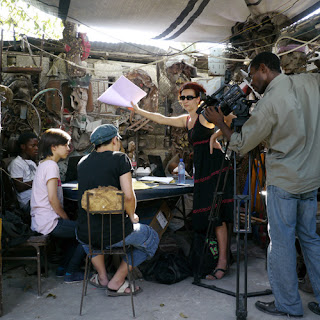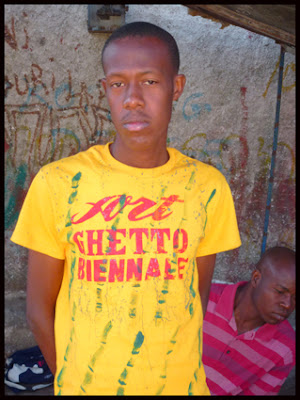 |
| Andre Eugene Badgi Pom Louko(Altar for Louko) (2011) |
Sebuah
negeri miskin luluh lantak, dua tahun silam terkena gempa. Penduduknya tidak
menyerah, melihat takdir dengan rasa optimis dan tetap menyelenggarakan festival seni yang dianggap parodi kemapanan
biennale dunia.
Jamak dikritik
publik seni dengan ungkapan a Salon des
Refusés for the 21st century, sebuah
pameran oposisi pada abad ini. Konon, awalnya event Ghetto Biennale ke-1 pada 2009 diselenggarakan gara-gara banyak seniman
Haiti tidak terseleksi di Biennale mapan dunia.
Kurator Leah
Gordon menyebut bahwa penggagas awal acara, kelompok seniman di Grand Rue menggunakan
sistem magang untuk menyebarkan keterampilan pada komunitasnya.
Perbedaan dalam
memproduksi seni yang aneh dan kurangnya pengetahuan seni serta sejarah konvensional seni barat sering memaksa
mereka dimasukkan di kategori “outsider art” atau “ naive art”. Dengan acara Biennale
Ghetto mereka mengundang seniman kontemporer, ingin mengabarkan pada dunia, menolak
posisi yang demikian.
Benarkah
begitu? Yang jelas, dibalik kontroversi yang ada, dukungan makin bertambah banyak dari seluruh pelosok jagad. Seniman-seniman seperti arsitek, desainer, pematung, seniman konseptual,
seniman kostum, performance artist, perupa instalasi dll dari berbagai “kelas” hadir dan
berpartisipasi. Bahkan membiayai sendiri seluruh kunjungan ke Haiti dan
produksi karyanya.
Maka, acara
yang berlangsung di Grand Rue,
distrik miskin sebuah “kampung kumuh” di Port-au-Prince di Haiti berlangsung
sampai dua kali. Gempa bumi pun tidak menyurutkan langkah mereka, apalagi
kendala infrastruktur fisik, absennya fasilitas semacam galeri nasional atau museum representatif tentu
saja tidak membuat ciut nyali.
A country
that has been devastated by the earthquake on 2010 did not give up. The people still held arts festival which is
considered a parody for the world Biennale.
They used to be criticized as an expression of the Salon des refuses for the 21st Century, an exhibition of the opposition.
Many people say that the Ghetto Biennale was held because there are a lot of Haitian artists denied their presence by the arena of world Biennale.
Curator Leah
Gordon said that the initiators of Ghetto Biennale, the Grand Rue group of
artists using the apprenticeship system to deploy the skills in their
communities.
With the difference in the way of producing art and lack of knowledge about the history of Western art that compels them have been placed in a category of "outsider art" or "naive art".
The
existence of the Ghetto Biennale and contemporary artists who have been
invited to Haiti is an attempt to refuse those position. Behind the controversy,
the clear support even increased a lot from all over the world.
Painter,
architect, sculptor, performance artist, costume making artists, coceptual
artist, installation artist have come from different "classes" to work and participate.
They have self-financed the entire visit to Haiti and producing work by
participating directly in the local community.
In the end,
the event was already held two times in the Grand Rue, poor areas or "slum
kampoong" in Port-au-Prince in Haiti. As we know, even a natural disaster
did not discourage them to continue moving forward.
.JPG) |
| Charlotte Hammond 1 |
 |
| Charlotte Hammond 2 |
 |
| Fungus Collective 1 |
 |
Fungus Collective 2 Fungus Collective 3  Fungus Collective 4 |
 |
Maccha Kasparian 1 Maccha Kasparian 2  Maccha Kasparian 3 |
 |
Pascal Giacomini 1 |
 |
Peter Anderson 1 |
 |
| Schallum Pierre1 |
 |
| Schallum Pierre 2 |
 |
| Allison Rowe 1 |

No comments:
Post a Comment